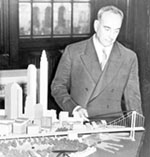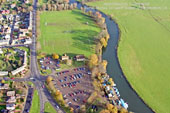New York is its architecture and its architecture is what has made New York what it is.
And it is largely thanks to the work of a single man.
A contradictory figure that defined New York's architecture without being an architect and played a key role in the city's political development without being a politician.
His name is Robert Moses.

Moses was a conservative Republican who worked for capitalism's best interests. Lucky for him, he also knew how to dress his urbanism with a certain modernity that transformed him in the representative of the "modern international style" within urban planning.
He essentially shaped the New York we know today. The New York that prefers cars to people, that's his obsession with roads and expressways. The New York with the ruined South Bronx, that's his doing. He forged the disappearance of the once-landmark Coney Island. He practically forced the Brooklyn Dodgers and the New York Giants Major League baseball teams out of the city. He neglected public transport until it declined.
But he also did what no public official could ever do before him. He built parks (Riverside Park, to name just one), roads (the Cross-Bronx and the Major Deegan and the Bruckner), the Henry Hudson Bridge and the Triborough Bridge. He did all this is popular neighborhood where powerful men had sworn he would never build them.
He was ruthless when commading his army of steamrollers. He destroyed a big part of Manhattan and, in return, built a new, modern city. His critics claim this modern city is now outdated and old and decrepit, but in his defense it could be said that he just rose up to the occassion. It is not easy to operate on New York. Few cities have its concentration and saturation. The old and the new are in a permanent struggle against each other.
Any attempt towards innovation begs to pit the legacy of the past against the necessities of the future. Also, when he began his reign towards the 1950s, it was such an expansive moment, when the U.S. was gaining power over the international scene that there was a general feeling that a new, dinamic urbanism was necessary.
Perhaps the best thing that could be said to define him is his unappealable yet involuntarily sinister name for destruction in the sake of improvement: the scythe of progress.
In the early 1950s, his scythe of progress was ready to do away with some of Manhattan's most civilized neighborhoods: a ten-lane expressway was supposed to run through SoHo, Little Italy, Chinatown and the Lower East Side.
One never really knows how unstable civilization is, how dangerous it is to take anything for granted. In order to thank the sublime pleasure of walking around Washington Square, or stare at the street musicians and tumblers, or the chess players, or the delight of sitting in the grass and watch in the horizon the towers that comprise Fifth Avenue over the treetops, one must realize that all this was about to be destroyed decades ago.
That was the place Robert Moses had dictated his expressway should run through. The scythe of progress doesn't act out of mere whim: if the traffic is to flow at a certain speed through the island, the rational, the inevitable, is to make way for it.

Washington Square wasn't saved by any architect. No expert in urbanism rose his voice against what today seems like an inconceivable crime. Washington Square exists today thanks to a woman, called Jane Jacobs. She was no expert. She didn't even have a college degree. She lived near Hudson Street, in the heart of The Village, y she would take her kids to play in Washington Square.
Her first comrades in the revolt where the mothers of his kids' friends. "A few crazy ladies with strollers," Moses defined them. And yet, they succeeded.
In 1961, when Washington Square and the Village streets were out of danger thanks to the rebellious movement Jane Jacobs had initiated, she wrote a book, a beautiful manifest in defense of walker-friendly streets. It was called The Death and Life of Great American Cities. She died a tiny, brave woman, committed to her defense of that fragile and necessary lifestyle that is civilization and cannot live without cities.
And that's what New York's architecture -- New York in general -- is all about. A powerful man tries to control the city. And the people, using the people's reasoning, counterbalances him. We owe as much to Robert Moses as we do Jane Jacobs.